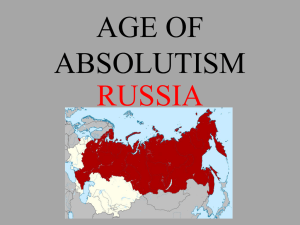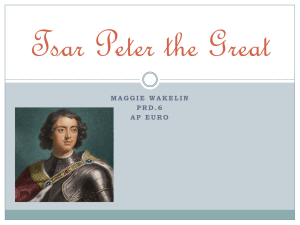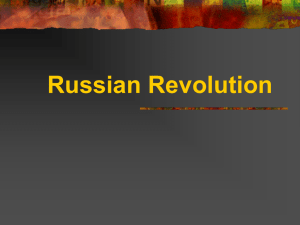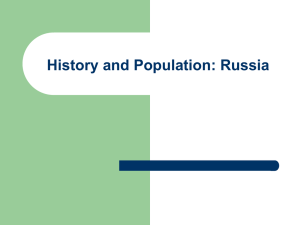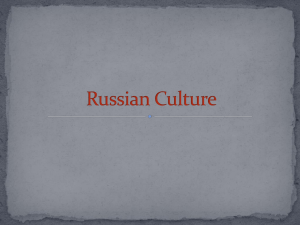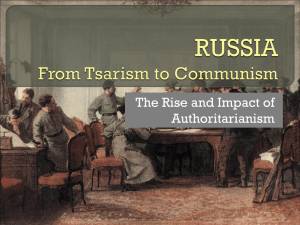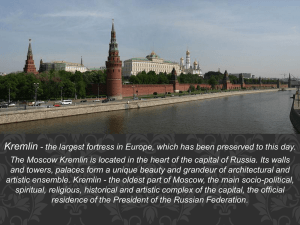Absolutism in Russia
advertisement
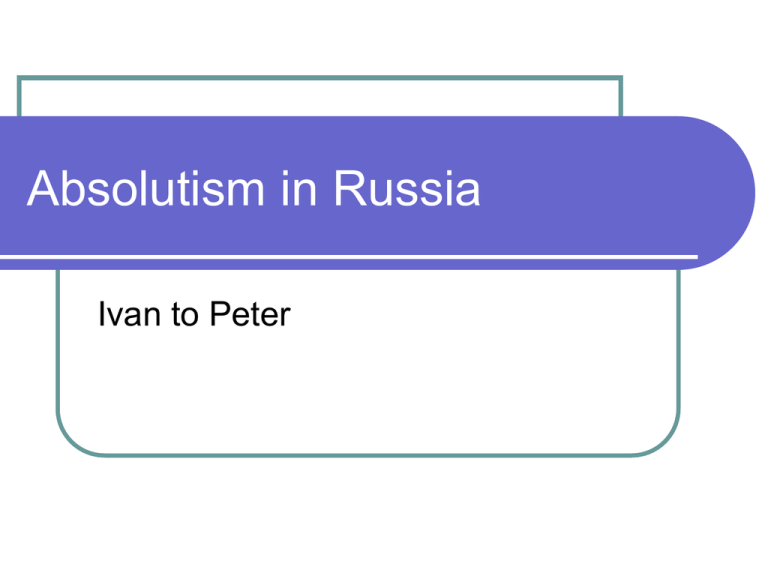
Absolutism in Russia Ivan to Peter Russian Beginnings before 9th C Many Ethnic Groups in Russia Scythians Alans Finns Turks Magyars Siberia “Permafrost” Average temperatures of January vary from 0 to -50°C, and in July from 1 to 25°C A former “gulag” Soviet prison camp. 150,000,000 population. Slavs move in Farmers Grew barley, wheat, rye Traded forest products: Timber, fur, fish Vikings take over Slavs peaceful—do not fight Rurik moves in: First Viking Ruler Oleg, his successor, captures Kiev Early Russia Kieven Rus Good location for trade On Dnieper River Constantinople nearby Trade forest products for manufactured goods and ideas Early Byzantine Influences: Orthodox Christianity Early Byzantine Influences: Orthodox Christianity Cyril and Methodius Monks 850 AD left Constantinople to spread Christianity to Slavs Created Cyrillic language Taught Slavs their alphabet— from Greek language Early Byzantine Influences: Cyrillic Alphabet 988—Vladimir I Vladimir renounces his pagan ways and wives Accepts Christianity 999—orders all Kievens to be baptized Christian world—one leader: Pope in Rome 1054—Christianity splits Patriarch of Constantinople refused to accept Papal Supremacy Split continues today Eastern/Greek Orthodoxy centered in Constantinople 1453—Constantinople Falls Turks sack Constantinople Power of patriarch reduced Russian Church leaders gain power 16th Century Church Russia independent of Greek Orthodox Church Rejected control of Patriarch in Constantinople Moscow becomes center of Russian Orthodoxy Patriarch’s influence Russian Patriarchs close to Tsars Encourage strong control over Peasants Russia separated from Western Ideas Split with Rome Russian Separation Native Russian used in Church, not Latin Russian scholars isolated from intellectual developments in West Decline of Kieven Rus Despite advantages: good soil, rivers, Black Sea trade Many Problems: Succession of Rulers had to hold territorial seats to become ruler Threats of (Mongol) nomads, Loss of Northern trade 1223: Golden Horde Enters Russia Batu Khan+ Gold Colored tents 1240: sacks Kiev Only Novgorod Free, but forced to recognize Tatar Ruler for 200 years Novgorod Mongol Rule Loose control of Russia Russians paid tribute to Khan Could manage their own affairs Russian Princes wanted to unite, Appealed to West for help— none came The Mongols Invade Russia Mongol Rule No help from West Asian customs adopted Women’s status declined Slavs poor; few rights Tatar words, clothing, architecture accepted Autocracy Emergence of Moscow Moscow Princes gained favor from Tatars Right to collect taxes Moscow River replaces Dnieper as main trade route 1299—Head of Russian Orthodox church moves to Moscow Moscow Church became unifying factor for Russian People under Tatars Moscow strongest and largest of small Russian states Gains control over lesser Princes Ivan III 1462-1505 Ivan the Great: Founder of Russian Nation State 1st to use title “Tsar” Refused to pay tribute to Tatars Mongols divided; lost power Ivan the Great (r. 1462-1505) Ivan III Tearing the Great Khan’s Letter Requesting More Tribute in 1480. Ivan III 1462-1505 1472: married Sophia, niece of last Byzantine emperor Moscow becomes 3rd Rome— New holy city Autocratic rule Serfdom in Russia Before Tatar invasion, serfs free to move around Invasion destroyed: fields, animals, buildings Peasants sold labor or promised part of their crops to get loans Serfdom in Russia Poorest most vulnerable could not pay off debt Debt serfdom replaced by legal serfdom Serfs tied to land by law Could not move Serfdom in Russia As nobility grew, so did serfdom; Labor laws passed Peasants stayed on land and worked for landowners Deadening effect on economy Inefficient work Serfdom in Russia Serfs not motivated as in West Serfs poor Whole nation affected Lasts until 1861 Ivan IV 1533-1584 Grandson of Ivan III Orphaned at age 8 Becomes Tsar at 17 Extended Russian boundaries and drove to Siberia Destroyed power of Boyars Ivan IV 1533-1584 Thousands executed Kills Ivan, his oldest son 1584—Russia stronger Time of Troubles 1584-1613 Who will be heir? Dmitri, child of Ivan’s 7th wife would not be recognized by the Church Feodor was retarded; spent most of his time in prayer Time of Troubles Feodor ‘ruled’ 14 years Boyars began fighting autocracy Boris Godunov becomes regent Defeated the Romanov family (killed many important members; they were still popular w/people) Time of Troubles 1591: mysterious death—10year old Dmitry is found dead, with his throat cut Death ruled accidental: he was playing with a knife and had an epileptic seizure; killed himself Was it Godunov? Time of Troubles 1598 Feodor dies w/out heir Boris Godunov is elected Tsar by zemsky sobor Godunov: popular, experienced in government, honorable Time of Troubles Godunov tries to stabilize Russia: destroy boyars, rest of Romanovs Favored enlightenment Tried to set up university in Moscow—church balked Sent students abroad to study Time of Troubles 1601: Drought/famine hit Russia Godunov tried to collect and redistribute food; 1 million die Armed mobs ravaged towns, looking for food Time of Troubles Rumors spread that Dmitry was not really dead—they knifed the wrong boy A young man appears and claims to be the true prince of Russia (False Dmitry I) Time of Troubles False Dmitry I got recognition from Poland; In exchange for support, he promised to make Russia Catholic once he takes the throne Time of Troubles 1604: Polish Warriors, Cossacks, peasants support False Dmitry I; invade Russia Boris Godunov fought, but with victory in sight, Godunov becomes sick and dies 1605: False Dmitry entered Moscow—crowned Tsar Time of Troubles False Dmitry reigned 13 months Poles antagonized Muscovites, tried to make them submit to Catholicism Time of Troubles Finally, Prince Vasily Shuisky organizes Russian soldiers, townsfolk Slaughtered the Poles; executed False Dmitry; burned his remains Stuffed them into a cannon and fired towards Poland Elected Shuisky Tsar Time of Troubles 1606-1613 Shuisky is a BoyarTsar: no power base Ivan Bolotnikov led a mass revolt of Cossacks, runaway peasants, and vagabonds against all authority and property owners; reached Moscow before it was defeated Time of Troubles Other Pretenders tried to take the throne: False Dmitry II—set up headquarters in Tushino: 2 Tsars w/equal followers 1610 Shuisky deposed False Dmitry II murdered over $ Time of Troubles Russia had no Tsar, no government Ineffective Duma (led by boyars) tried to rule Western claims made: Sweden, Poland seized territories Time of Troubles Russian People rallied together: Begun in churches “3rd Rome must not be allowed to fall to Catholic ‘heretics’ of the West” Time of Troubles Citizens of Novgorod gave 1/3 of all possessions to finance crusade Great national army formed: Marched on Moscow and wiped out the Polish garrison there Neither Poland nor Sweden challenged it Time of Troubles Zemsky Sobor elected new Tsar: 16 year old Michael Romanov Acceptable to Muscovites and Cossacks: linked to Ivan IV by marriage Time of Troubles ends Michael is weak Tsar Son Alexis and grandson Feodor III also weak 1689: Peter I crowned Tsar

